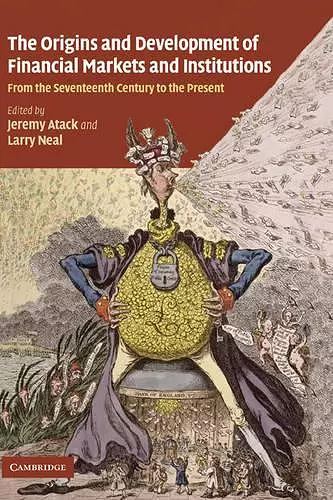The Origins and Development of Financial Markets and Institutions
From the Seventeenth Century to the Present
Larry Neal editor Jeremy Atack editor
Format:Hardback
Publisher:Cambridge University Press
Published:16th Mar '09
Currently unavailable, and unfortunately no date known when it will be back
This hardback is available in another edition too:
- Paperback£50.99(9780521154765)

Leading historians examine how financial innovations have challenged established institutional arrangements from the seventeenth century to the present.
Finance has proved to be one of the most important causal factors in economic performance. In a series of original essays, leading historians examine how financial innovations from the seventeenth century to the present have challenged established institutional arrangements, forcing change and adaptation by governments, financial intermediaries, and financial markets.Collectively, mankind has never had it so good despite periodic economic crises of which the current sub-prime crisis is merely the latest example. Much of this success is attributable to the increasing efficiency of the world's financial institutions as finance has proved to be one of the most important causal factors in economic performance. In a series of insightful essays, financial and economic historians examine how financial innovations from the seventeenth century to the present have continually challenged established institutional arrangements, forcing change and adaptation by governments, financial intermediaries, and financial markets. Where these have been successful, wealth creation and growth have followed. When they failed, growth slowed and sometimes economic decline has followed. These essays illustrate the difficulties of co-ordinating financial innovations in order to sustain their benefits for the wider economy, a theme that will be of interest to policy makers as well as economic historians.
Review of the hardback: 'Atack and Neal bring together a brilliant, provocative and authoritative set of essays on financial history. The essays share the desire to link social, political, and economy history with finance, to place financial development within the story line that connects financial changes to the development of commerce, industry, and politics. The coverage is broad in space and time, covering all aspects of finance - money, banking, central banking, securities markets, and financial crises - in many countries and over four centuries of change. The authors are the leading authorities in their field. Although the articles are carefully argued and rich in quantitative detail, they are exceptionally lively because they combine the discipline of economic analysis with a broader historical narrative that brings to life the personal histories of financiers as part of the broader arc of European and American financial development. The book is more than a collection of great studies of the past; it is also a tool to teach historians how to think about finance, and to teach financiers how to think about history.' Charles Calomiris, Columbia University Graduate School of Business
Review of the hardback: 'In this splendid collection, distinguished financial historians from many countries discuss the most important features of financial markets and institutions, covering a great span of time from the seventeenth century to the recent past. Larry Neal himself has written a masterly summary of the main findings that brings out lessons learned in the past and those that were missed. This book should be put in the hands of regulators and central bankers everywhere. They would benefit from reading more financial history of this kind.' Forrest Capie, Official Historian, Bank of England, and Cass Business School
Review of the hardback: 'The credit crisis in the United States has created new doubts, not least in academic circles, about the advantages of sophisticated financial markets. This collection by Atack and Neal is therefore all the more timely as a reminder that financial development, done right, solves more problems than it creates. In its use of history it is also a reminder of the need to avoid fighting the last war. Financial institutions and markets are in a continuous state of flux and the consequences of regulatory responses are not always as expected. There are lessons here, in other words, not just for historians but for policymakers and investors.' Barry Eichengreen, University of California, Berkeley
ISBN: 9780521895170
Dimensions: 235mm x 158mm x 30mm
Weight: 920g
496 pages